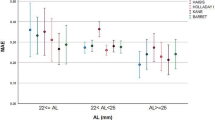Summary
In a European co-operative research 43 normal human lenses, aged 2.5 to 84.5 years, were analyzed with regard to the development of their wet and dry weights in the course of life, and the relation between the two was investigated. Simple exponentional functions were adapted to the data. It has not been possible to force the curves through the zero point, i.e. the beginning of lens differentiation. Wet and dry weight of the lens seem to increase until death, however, the growth rate decreases considerably with age. The dry weight portion of the lens, being 1/3, is rather constant for the better part of life. However, the individual variability is greater than might be assumed. It has not yet been possible to elucidate whether the lenses of children under the age of 10 generally have a higher water content than those of people above eighty years of age. The growth curves will have to be continually corrected according to the latest data obtained, especially if information on periodical increases of the growth rate during the embryonic phase or at an advanced age will be available.
Zusammenfassung
Aus einer europäischen Gemeinschaftsarbeit wurden 43 Augenlinsen von Gesunden zwischen 2,5 und 84,5 Jahren hinsichtlich der zeitlichen Entwicklung ihrer Naß- und Trockengewichte sowie deren Beziehung zueinander analysiert. Einfache Exponentialfunktionen wurden den Daten angepaßt. Hierbei gelang es nicht, die Kurven durch den Nullpunkt zur Zeit des Beginns der embryonalen Entwicklung des Linsenbläschens zu zwingen. Naß- und Trockengewicht der Linse scheinen bis zum Tode zu wachsen, jedoch bringt das Altern eine ganz erhebliche Verlangsamung. Der Trockengewichtsanteil der Linse beträgt während des größten Teils des Lebens ziemlich konstant ein Drittel. Die individuelle Variabilität ist jedoch größer, als man nach dem ersten Eindruck vermutet. Ob Kinder unter 10 Jahren im Mittel einen größeren und Greise über 80 Jahren einen kleineren Wassergehalt haben, kann noch nicht entschieden werden. Die Wachstumskurven werden durch Hinzukommen neuer Daten noch Korrekturen erfahren müssen. Insbesondere wird man über eventuelle Wachstumsschübe während des embryonalen Lebens und im Alter mehr Informationen erhalten.
Similar content being viewed by others
Literatur
Fink, H., Hockwin, O., Weigelin, E.: Growth curve of the eye lens of some domestic and test animals. Ophthal. Res. 1, 321–337 (1970)
Graeber, W.: Die Gewichts- und Volumenzunahme der menschlichen Linse in Abhängigkeit vom Alter. Acta XX. Conc. ophthal. Germania 1, 493–495 (1966)
Heyningen, van, R.: The human lens. III. Some observations on the postmortem lens. Exp. Eye Res. 13, 155–160 (1972)
Hockwin, O., Bechtel-Ehrig, U., Licht, W., Noll, E., Rast, F.: Concerning the estimation of the age of guinea-pigs, rabbits and chickens by means of determining their lens weight. Ophthal. Res. 2, 77–85 (1971)
Jess, A.: Beiträge zur Kenntnis der Chemie der normalen und pathologisch veränderten Linse des Auges. Z. Biol. 61, 92–142 (1913)
Johansen, E. V.: Undersøgelser over det indbyrdes Størrelsesforhold mellem Cornea og Lens crystallina hos Mennesket. København: Munksgaard 1947
Krause, A. C.: The chemistry of the lens. The nature of the lenticular proteins. Amer. J. Ophthal. 17, 502–514 (1934)
Mach, H.: Untersuchungen von Linseneiweiß und Mikroelektrophorese von wasserlöslichem Eiweiß im Altersstar. Klin. Mbl. Augenheilk. 143, 689–710 (1963)
Maraini, G., Pescatori, A.: Changes in weight and in protein — water ratio of the lens in human senile cataract. Ophthal. Res. 3, 108–113 (1972)
Maraini, G., Santori, M., Carta, F.: Modifications of adenosine triphosphate and of some enzymatic activities during the development of human senile cataract. Exp. Eye Res. 6, 126–129 (1967)
Martius, H.: Lehrbuch der Geburtshilfe, 3. Aufl., S. 150. Stuttgart: Thieme 1956
Pau, H.: Beitrag zur Kataraktgenese. Albrecht v. Graefes Arch. Ophthal. 150, 340–357 (1958)
Satoh, K.: Age related changes in the structural proteins of human lens. Exp. Eye Res. 14, 53–57 (1972)
Scammon, R. E., Hesdorffer, M. B.: Growth in mass and volume of human lens in postnatal life. Arch. Ophthal. 17, 104–112 (1937)
Smith, Pr.: On the growth of the crystallin lens. Trans. ophthal. Soc. U.K. 3, 79–99 (1883)
Author information
Authors and Affiliations
Rights and permissions
About this article
Cite this article
Nordmann, J., Fink, H. & Hockwin, O. Die Wachstumskurve der menschlichen Linse. Albrecht von Graefes Arch. Klin. Ophthalmol. 191, 165–175 (1974). https://doi.org/10.1007/BF00414943
Received:
Issue Date:
DOI: https://doi.org/10.1007/BF00414943




